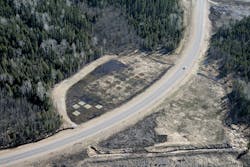The state of Minnesota has a rather diverse ecological and geographical environment, with a majority of agriculture and farmland to be found in the southwest region of the state, while wild, forested lands still heavily occupy the northwest.
As such, the Minnesota Department of Transportation (MnDOT) approaches wetland mitigation projects differently in the two areas of the state.
When wetlands are impacted by road construction projects, the Minnesota Wetland Conservation Act requires that either the already existing wetlands are restored or that new wetlands are created in an alternate location. With a limited amount of wetland acreage in existence in the southwest, the opportunities for wetland restoration are ripe in the region. However, as the northwest retains over 80% of its historical wetlands, the chances of finding an area that would serve as a functional prospective candidate for wetland restoration are slim.
As wetland creation is a more difficult task than wetland restoration, MnDOT undertook an investigative project to determine whether or not soils from wetlands affected by road construction could be salvaged and used to create wetlands in the gravel pits that provide construction aggregate, otherwise known as borrow areas.
An aerial view of the Natural Resources Research Institute’s mitigation wetland demonstration sites, constructed in adandoned gravel pits along Hwy. 53 in northern Minnesota. The success of the study is keeping MnDOT researchers hopeful. (Photo courtesy: UMD_NRRI)
Creation through borrowing
The question that MnDOT sought to have answered was whether or not creation in sites that were never wetlands could produce results as agreeable as wetland restoration, particularly for areas in the northeast, where gravel pits that were excavated for road construction materials can serve as borrow areas for wetland creation sites.
“In the northeast, where there are a lot of wetlands, the options for wetland restoration are very minimal,” Sarma Straumanis, wetlands program coordinator for MnDOT, told Roads & Bridges. “So we were looking at the options that we had, and we did notice that wherever we do have the gravel pits, those [areas] would be a good opportunity for a wetland to be created.”
Straumanis explained that the gravel pits work well as borrow areas for a number of reasons. Besides having the ability to serve the dual purpose of supplying both the borrow material and the creation site, these gravel pits are fitting because of the environment in which they exist, since they are already surrounded by wetlands. Their location became an advantage for MnDOT, as regulations for wetland replacement mandate that wetland replacement sites are as close to impacted sites as possible and that they are the same kind of wetland that was impacted. These wetland categories are more likely to include meadows, swamps and bogs, rather than ponds or open-water marshes.
The elements needed to create a wetland include soil, hydrology and vegetation. As long as one of those elements is still intact from a former wetland site, wetland restoration is possible. However, where no elements from an impacted wetland exist, creating a new one requires starting from scratch.
Ken Graeve, a botanist at MnDOT, explained that creation projects in the northeast required bringing in those elements from other sites. Project engineers on wetland creation projects are not working on landscape features where they can just restore hydrology. “They have to, using these gravel pits, build it and grade it in a way where they can achieve the right water level,” Graeve told Roads & Bridges. He went on to explain that soil had to be brought in since there was not much soil to work with in gravel pits. “Instead of just bringing in any old soil, they would bring the soil and the peat from the very next wetland that they were impacting, and they haul that back to one of the used-up borrow areas and spread it.”
Preparing for invasion
To carry out the investigation of the effectiveness of wetland creation, MnDOT researchers constructed and monitored 12 wetland mitigation sites along U.S. 53 north of Virginia, Minn. In addition, they continued to monitor two sites as part of an older project on “Wetland Mitigation in Abandoned Gravel Pits.”
This project used the innovative process of staging construction for concurrent wetland creation by preparing spent borrow pits to receive donor soil from the next impacted wetland. Waste material (wetland soils) was matched with waste sites (spent pits) to recreate a natural resource and meet regulatory requirements. This saved money and space, and enabled the environmental compliance to blend in with the road construction.
According to Graeve, early results from the mitigation sites were promising, as the wetlands started out growing excellently. “Because they used the donor [plant] material from the wetlands that were impacted, there were a lot of native plants that were coming in really well,” Graeve said. “Most created wetlands don’t look nearly as good as these do.” The researchers concluded that these mitigation sites had adequate hydrology characteristics, meeting standards for mixing standing water and saturated soils that either matched or exceeded the quality of many restored wetlands in the state.
However, another conclusion drawn from this project was the fact that these created wetlands could benefit from invasive species control. Graeve surmised that efforts to manage invasive species needed to happen earlier in the process of wetland mitigation to prevent those species from ruining the planting in the created wetland sites in terms of native vegetation and biodiversity. “If they’re controlled early on, while the native plants are getting established, those native plants can eventually hold their own and keep those weeds from growing in,” he said.
“Controlling invasive species isn’t just a science, it’s an art, because you’re reacting to what Mother Nature throws at you,” Straumanis added, noting that particular weather patterns such as flooding or dry seasons impacted the success of the creation of these wetlands in addition to invasive species. “You’ve got this prescriptive cookbook approach in principle, but then you have to really be flexible and adapt, and that can be really difficult.”
Researchers also concluded that mitigation sites would benefit from more trees planted on the sites to improve wetland quality as well as reducing and stabilizing water levels to minimize standing water amounts.
A project botanist (top) and representatives from MnDOT and the Board of Water and Soil Resources look at the new wetland’s progress. (Photo courtesy: UMD-NRRI)
Getting credit
Current wetland conservation rules dictate that 1 acre of wetland creation yields only 0.75 acres of credit in Minnesota’s wetland banking system, as opposed to obtaining a full acre of credit back for wetland restoration. “Creation has been looked at skeptically, and you don’t get full credit if you do wetland creation,” Straumanis said.
The success of this study is keeping MnDOT researchers hopeful that the possibilities of creating high-quality wetlands will be proven in the future on other projects. “We were hoping the results of this study would give us some leverage and some data information to make the argument that one should be able to get 100% credit for an acre of wetland creation,” Straumanis added. “But this is one study, one set of results; and there are hundreds of people that need to be convinced of that, so it’s a start.”


